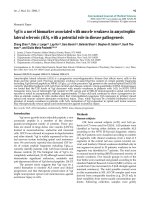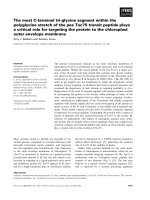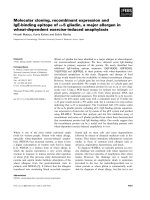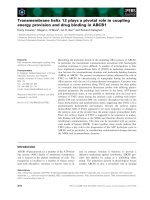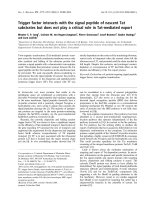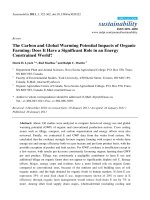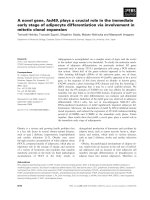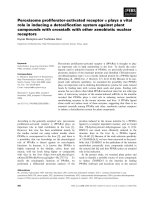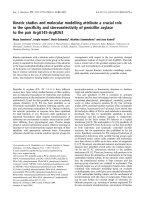NR2F2 plays a major role in insulin-induced epithelial-mesenchymal transition in breast cancer cells
Bạn đang xem bản rút gọn của tài liệu. Xem và tải ngay bản đầy đủ của tài liệu tại đây (1.47 MB, 12 trang )
Xia et al. BMC Cancer
(2020) 20:626
/>
RESEARCH ARTICLE
Open Access
NR2F2 plays a major role in insulin-induced
epithelial-mesenchymal transition in breast
cancer cells
Baili Xia1†, Lijun Hou1†, Huan Kang1, Wenhui Chang1, Yi Liu1, Yanli Zhang1 and Yi Ding1,2*
Abstract
Background: The failure of treatment for breast cancer usually results from distant metastasis in which
the epithelial-mesenchymal transition (EMT) plays a critical role. Hyperinsulinemia, the hallmark of Type 2 diabetes
mellitus (T2DM), has been regarded as a key risk factor for the progression of breast cancer. Nuclear receptor
subfamily 2, group F, member 2 (NR2F2) has been implicated in the development of breast cancer, however its
contribution to insulin-induced EMT in breast cancer remains unclear.
Methods: Overexpression and knockdown of NR2F2 were used in two breast cancer cell lines, MCF-7 and MDAMB-231 to investigate potential mechanisms by which NR2F2 leads to insulin-mediated EMT. To elucidate the
effects of insulin and signaling events following NR2F2 overexpression and knockdown, Cells’ invasion and
migration capacity and changes of NR2F2, E-cadherin, N-cadherin and vimentin were investigated by real-time
RT-PCR and western blot.
Results: Insulin stimulation of these cells increased NR2F2 expression levels and promoted cell invasion and
migration accompanied by alterations in EMT-related molecular markers. Overexpression of NR2F2 and NR2F2
knockdown demonstrated that NR2F2 expression was positively correlated with cell invasion, migration and the
expression of N-cadherin and vimentin. In contrast, NR2F2 had an inverse correlation with E-cadherin expression. In
MDA-MB-231, both insulin-induced cell invasion and migration and EMT-related marker alteration were abolished
by NR2F2 knockdown.
Conclusions: These results suggest that NR2F2 plays a critical role in insulin-mediated breast cancer cell invasion,
migration through its effect on EMT.
Keywords: Breast cancer, NR2F2, Insulin, Epithelial-mesenchymal transition, Migration, Invasion metastasis
Background
Breast cancer and diabetes are major worldwide health
care problems. Accumulating evidence indicates that
type 2 diabetes mellitus (T2DM) increases the risk of
developing breast cancer [1, 2]. The potential molecular
* Correspondence:
‡
Baili Xia and Lijun Hou are Co-first author.
1
Department of Pathophysiology, Weifang Medical University, Weifang
261053, China
2
Key Laboratory of Applied Pharmacology, Weifang Medical University,
Weifang 261053, China
mechanisms contributing to this malignancy have been
suggested by the role of hyperinsulinemia, a hallmark of
T2DM, and a key risk factor for the development of
breast cancer [3]. Long-term use of insulin analogs, insulin glargine, is associated with an increased risk of breast
cancer in women with T2DM [4, 5]. Two large studies
indicated that serum insulin is positively associated with
breast cancer risk [6, 7]. Breast cancer has also been
found associated with elevated levels of endogenous
circulating insulin in non-diabetic patients [8]. A recent
© The Author(s). 2020 Open Access This article is licensed under a Creative Commons Attribution 4.0 International License,
which permits use, sharing, adaptation, distribution and reproduction in any medium or format, as long as you give
appropriate credit to the original author(s) and the source, provide a link to the Creative Commons licence, and indicate if
changes were made. The images or other third party material in this article are included in the article's Creative Commons
licence, unless indicated otherwise in a credit line to the material. If material is not included in the article's Creative Commons
licence and your intended use is not permitted by statutory regulation or exceeds the permitted use, you will need to obtain
permission directly from the copyright holder. To view a copy of this licence, visit />The Creative Commons Public Domain Dedication waiver ( applies to the
data made available in this article, unless otherwise stated in a credit line to the data.
Xia et al. BMC Cancer
(2020) 20:626
Fig. 1 (See legend on next page.)
Page 2 of 12
Xia et al. BMC Cancer
(2020) 20:626
Page 3 of 12
(See figure on previous page.)
Fig. 1 The effect of insulin on invasion and migration in MDA-MB-231 and MCF-7. a and b MDA-MB-231 cells and c and d MCF-7 cells were
scratched by a micropipette tip and then incubated with or without insulin for 24 h (both n = 4). Cells were photographed and the distance was
measured under microscope. e and f MDA-MB-231 cells and g and h MCF-7 cells were seeded separately into 8 μm-pole transwell chamber at
80~90% confluence. After starving for 12 h, monolayer cells were treated with or without insulin for 48 h, and then the filter was washed, stained
and photographed under a microscope (both n = 4). *P < 0.05, ** P < 0.01 vs. control
study illustrated that hyperinsulinemia promotes proliferation, migration and invasion of the human breast
cancer cell line MDA-MB-231 by upregulation of urokinase plasminogen activator and its activation depends
on production of reactive oxygen species (ROS) [9, 10].
Insulin promotes the growth of breast cancer cells in
nude mice, and increases the proliferation and migration
of MCF-7 human breast cancer cell line by upregulating
insulin receptor substrate 1 and activating the Ras/Raf/
ERK pathway [11, 12].
The nuclear receptor subfamily 2,group F, member 2
(NR2F2) gene encodes a member of the steroid thyroid
hormone superfamily of nuclear receptors and is a
member of chicken ovalbumin upstream promotertranscription factors (COUP-TFs) superfamily, also
known as COUP-TFII or ARP-1 [13–15]. It regulates
glucose and lipid metabolism and is involved in the
regulation of several important biological processes, such
as neurogenesis, organogenesis, cellular differentiation
during embryonic development and metabolic homeostasis [16]. Heterozygous NR2F2-knockout mice displayed lower basal level of insulin and enhanced insulin
sensitivity compared to wild type mice [17, 18]. Recently,
two opposing roles of NR2F2 on promoting or inhibiting
tumorigenesis and metastasis have been reported.
Higher expression of NR2F2 was associated with a worse
prognosis and lymph node metastasis in human breast
cancer cases [19]. In contrast, conditional ablation of
NR2F2 severely compromised neoangiogenesis and suppressed tumor growth in xenograft mouse model [20].
Tumor growth and metastasis were inhibited in a spontaneous mammary-gland tumor model in the absence of
NR2F2 by regulation of angiopoietin-1 [19]. Yet, the expression of NR2F2 has an inverse correlation with tumor
grade in breast cancer [21]. Similarly, low NR2F2 transcription levels correlated with increased grade and
lymph node metastasis based on the study of GEO and
TCGA database [22] suggesting that high NR2F2 transcription levels are associated with favorable clinic outcomes through suppression of transforming growth
factor - β (TGF-β) induced EMT.
The opposing effects of NR2F2 expression on cancer
cell growth and metastasis indicate the complexity of its
role in cancer. In the current study, we studied the effect
of NR2F2 on insulin-mediated EMT in the breast cancer
cells lines, MDA-MB-231 and MCF-7. We found that
NR2F2 played a crucial role in insulin-mediated EMT in
breast cancer cells by increasing vimentin and Ncadherin and inhibiting E-cadherin levels.
Methods
Cells culture and reagents
The human breast cancer cell lines MDA-MB-231 and
MCF-7 were obtained from American Type Culture Collection (Manassas, VA, USA). MDA-MB-231 cells were
cultured in RPMI1640 medium (Hyclone, LA, USA) with
10% fetal bovine serum (FBS, Gibco, NYC, USA) at
37 °C in 5% CO2 incubator. MCF-7 cells were grown in
MEM medium (Hyclone, LA, USA) with 10% FBS and
0.01 mg/ml insulin (Sigma-Aldrich, SL, USA) at 37 °C in
5% CO2 incubator. Before insulin stimulation, cells were
pre-seeded in plates with insulin-free medium for 24 h.
Insulin was purchased from Sigma-Aldrich. Insulin was
dissolved in HCI solution (pH 2.0). The final concentrations of HCI solution (pH 2.0) in the culture medium
were less than 0.1%, and these amounts were also
included in the corresponding controls.
RNA isolation and quantitative real-time PCR (q-PCR)
Cells were seeded in 6-well plates at a density of 5 × 106
cells/well in insulin-free medium for 24 h. The next day,
cells were incubated in medium with or without insulin
for certain time and then total RNA was extracted using
RNeasy plus mini kit from Qiagen (Valencia, CA, USA)
as previously described [23]. Total RNA (2 μg) was
reverse-transcribed to cDNA (RT) with TaqMan Reverse
Transcription Reagents. cDNA was amplified by PCR
using the TaqMan probe for NR2F2 (Hs00819630_m1),
E-cadherin (CDH1, Hs01023894_m1), N-cadherin
(CDH2, Hs0098305_m1) and vimentin (Hs00958111_
m1). Glyceraldehyde 3-phosphate dehydrogenase
(GAPDH, Hs02758991_g1) was used as an endogenous
control. Quantitative real-time PCR was performed using
the TaqMan Universal PCR Master Mix. The PCR condition was denaturing at 95 °C for 15 s and annealing at
60 °C for 1 min with 40 cycles. Signals were analyzed by
the Light Cycler480-II, Roche, USA. All probes and reagents for reverse-transcription and PCR were purchased
from Thermo Fisher Scientific. Significant differences
between the treatment and the control values were determined by a two-tailed Student’s t test with a nominal
P value of < 0.05 considered significant.
Xia et al. BMC Cancer
(2020) 20:626
Fig. 2 (See legend on next page.)
Page 4 of 12
Xia et al. BMC Cancer
(2020) 20:626
Page 5 of 12
(See figure on previous page.)
Fig. 2 The effect of insulin on EMT marker expression. a MDA-MB-231 cells were treated with or without insulin (4 μM) for 24 h. The N-cadherin
and vimentin proteins expression were detected by western blot (n = 4). b MCF-7 cells were treated with or without insulin (4 μM) for 12 h. The
E-cadherin and vimentin protein expression were detected by western blot (n = 3). c MDA-MB-231 cells were treated with or without insulin
(4 μM) for 24 h, N-cadherin and vimentin mRNAs expression were detected by real-time RT-PCR. d and e MCF-7 cells were treated with or
without insulin (4 μM) for 24 h. The E-cadherin, N-cadherin and vimentin mRNAs expression were detected by real-time RT-PCR. * P < 0.05, ** P <
0.01 vs. control
Protein extraction and Western blot
Plasmid-mediated overexpression of NR2F2
Cells (3 × 105) were seeded into 6-well plate and incubated with or without insulin. As previously described
[24], proteins were extracted using RIPA buffer containing protease inhibitor cocktail and PMSF 1 mM (Solarbio, PRC). After centrifugation (12,000 g for 15 min at 4
°C), the supernatants were collected for western blot
analysis and the protein concentration was determined
using BCA Protein Assay kit (CWBio, Beijing, China).
Total protein (25 μg) was separated by 10% sodium dodecyl sulfate-polyacrylamide gel electrophoresis and
transferred onto a polyvinylidene fluoride membrane
(EMD Millipore, Billerica, MA, USA). The membranes
were blocked with 5% non-fat dry milk in TBST for 1 h
and then probed overnight at 4 °C with the following
antibodies of NR2F2 (1:1000 dilution, PPMX, Tokyo, JP),
β-actin (1:1000 dilution, Cell Signaling Technology, Boston, USA), vimentin (1:1000 dilution, Cell Signaling
Technology, Boston, USA), N-cadherin (1:1000 dilution,
Cell Signaling Technology, Boston, USA), and Ecadherin (1:1000 dilution, Cell Signaling Technology,
Boston, USA). The membranes were then blotted with
anti-mouse (1:5000 dilution, cat. no. A0216) and antirabbit (1:3500 dilution, cat. no. A0208) secondary antibodies (both from Beyotime Institute of Biotechnology,
Shanghai, China) for 1 h at room temperature. The
signal was detected using enhanced chemiluminescence
(Immobilon Western Chemiluminescent Horseradish
Peroxidase Substrate, EMD Millipore) and recorded on
X-ray film. Results are expressed as percentage of control, mean ± S.D.
The cells were seeded in 24-well plates at 80 to 90%
confluence overnight and then changed medium to
Opti-MEM® Reduced Serum Medium1 μg of plasmid for
human NR2F2 (pCMV-MCS-IRES-EGFP-SV40-Neomycin, Genechem, Shanghai, China) was added to each well
with Fugene HD (Promega,Madison, USA). An empty
vector was used as negative control. Twenty-four hours
later, the mRNA and protein expression of NR2F2 was
measured by quantitative RT-PCR and western blot
separately to confirm that NR2F2 was overexpressed
successfully and then cells were treated for the following
experiments.
RNA interference-mediated down regulation of NR2F2
The cells were seeded in 24-well plates at 30 to 50%
confluence overnight and then changed medium to
Opti-MEM® Reduced Serum Medium (Invitrogen, ThermoFisher, USA). 75 pmol of siRNA for human NR2F2
(Cat. no. 4390824, ID: s14021, Ambion, USA) was added
into cells with Lipofectamine 3000 (Thermo Fisher Scientific, USA) for siRNA transfecton as descried before
[23]. A non-target siRNA (Cat. no. 4390843, Ambion,
USA) was used as a negative control. Eight hours later,
the medium was changed back to regular medium. The
mRNA and protein expression of NR2F2 was measured
by quantitative RT-PCR and western blot separately to
determine the transfection efficiency.
Cell migration assay
Cell migration was examined with wound-healing experiments. Culture cells were seeded in 24-well plates at a
confluence of 80~90%. After 24 h, the confluent monolayer cells were scratched with a 200 μl micropipette tip,
washed twice with PBS to get rid of the excess cells and
treatment was applied. The cells were photographed and
the distance of migration was measured under Leica
Microsystems CMS GmbH (Leica, Germany).
Cell invasion assay
Cells in suspension were plated at the density of 2 × 105/ml
(150 ul/well) into the matrigel-coated insert of a transwell
chamber (Corning, PRC). The lower chamber was filled
with 60 μl of medium containing 10% FBS to induce
chemotaxis. Twenty-four hours later, the non-migrated
cells in the upper chamber were gently scraped away by
cotton swab, and adherent cells present on the lower surface of the insert were fixed with methanol, stained with 1%
toluidine / 1% borax solution, six fields were randomly
chosen from each chamber membrane and counted using
Image J software under microscope (Leica Microsystems
CMS GmbH).
Cell proliferation and viability
Cells were seeded in 96-well plates at 4 × 103 per well in
growth medium complemented with 10% FBS. Cell
proliferation/viability was evaluated using a [3- (4,5-dimethyl-2-thiazolyl)-2,5-diphenyl-2-H-tetrazolium bromide] (MTT, SIGMA, USA) assay at 6, 12, 24 and 48 h
after treatment. Cells were incubated with MTT solution
(5 mg/ml) in culture medium (20 μl per well) at 37 °C
Xia et al. BMC Cancer
(2020) 20:626
Fig. 3 (See legend on next page.)
Page 6 of 12
Xia et al. BMC Cancer
(2020) 20:626
Page 7 of 12
(See figure on previous page.)
Fig. 3 The effect of insulin on NR2F2 expression in breast cancer cells. a Protein expression of NR2F2 was measured in MDA-MB-231 and MCF-7
cells. b mRNA expression of NR2F2 was measured in MDA-MB-231 and MCF-7 (n = 5). c Dose effect of insulin at concentration of 0, 2, 4, 8, 16 μM
for 24 h on NR2F2 protein expression in MDA-MB-231 cells. d Time effect of insulin at 4 μM for 0, 3, 6, 12, 24 h on NR2F2 protein expression in
MDA-MB-231 cells. e NR2F2 mRNA expression was measured in MDA-MB-231 after insulin incubation for 24 h. f mRNA expression of NR2F2 in
MCF-7 cells was detected after cultured in insulin for 12 and 24 h. g MCF-7 cells were cultured in insulin for 12 and 24 h, NR2F2 protein
expression was detected. **P<0.01 vs. control
for 4 h. After centrifugation the medium was carefully
removed, 100 μl isopropanol was added to each well to
dissolve the formazan crystals. Optical density was recorded at 570 nm using a ultraviolet spectrophotometer
(Bio-tek instruments, USA).
Statistical analysis
A statistical analysis was performed using Student’s t-test
for comparing between 2 observations results, and oneway ANOVA was used for multiple comparisons. The
values are provided as the mean ± standard deviation (SD)
and were considered statistically significant at P < 0.05. All
experiments performed in vitro were biologically repeated
at least three times unless otherwise indicated.
Results
Insulin promotes the migration and invasion of breast
cancer cells
The effect of insulin on cell migration and invasion was
evaluated in a mesenchymal type (MDA-MB-231) and
epithelial type (MCF-7) cancer cells. Following incubation with insulin (4 μM for 24 h), the rates of migration
(Fig. 1a-d) and invasion (Fig. 1e-h) in both MDA-MB231 and MCF-7 significantly increased. However, the
rates of migration and invasion in the MDA-MB-231
cells were greater than that found in MCF-7 cells.
Insulin enhances the migration and invasion of breast
cancer cells through alterations in EMT-related molecular
markers
In order to assess whether EMT was involved in their
migration and invasion caused by insulin treatment, the
expression of specific EMT molecular markers were determined. Under basal condition, MCF-7 cells expressed
higher level of E-cadherin and less vimentin (N-cadherin
was undetectable, data not shown) while MDA-MB-231
cells expressed higher level of N-cadherin and less
vimentin (Fig. 2a-b). Following incubation with insulin
(4 μM for 24 h) in MCF-7 cells, insulin down regulated
E-cadherin mRNA expression and upregulated vimentin
mRNA expression (Fig. 2d). Similarly, insulin induced
N-cadherin and vimentin mRNA expression in MDAMB-231 cells (Fig. 2c).
Upregulation of NR2F2 expression by insulin
Basal expression of NR2F2 protein was greater in MDAMB-231 cells than MCF-7 cells (Fig. 3a-b). In MDAMB-231 cells, insulin treatment upregulated NR2F2 protein expression in a dose and time-dependent effect (Fig.
3c-d). In addition, after 24 h, insulin was associated with
increased NR2F2 mRNA expression (Fig. 3e). Levels of
NR2F2 mRNA and protein in MCF-7 cells were
increased by insulin at 12 h and 24 h (Fig. 3f-g).
NR2F2 over-expression enhanced EMT related markers
and MCF-7 breast cancer cell invasion
In an attempt to find whether NR2F2 can affect EMT related protein expression, NR2F2-vector and empty vector plasmid DNA were transfected into MCF-7 cells
respectively. In comparison to empty plasmid transfected
cells, NR2F2 mRNA expression level in the NR2F2plasmid DNA transfected cells increased up to 20 fold
(Fig. 4b). MCF-7 cells had low basal levels of endogenous NR2F2 protein expression, however, following
NR2F2 plasmid DNA transfection, the NR2F2 protein
expression increased up to 4–6 fold (Fig. 4a). The expression levels of N-cadherin and vimentin mRNA were
upregulated while the level of E-cadherin mRNA expression was downregulated by NR2F2 overexpression (Fig.
4d). The level of protein expression of E-cadherin was
downregulated and vimentin upregulated by NR2F2
overexpression in MCF-7 cells (Fig. 4c). The transfected
cells were evaluated by the cell invasion assay. The number of transmembrane cells significantly increased with
NR2F2 overexpression in comparison to empty vector
control (Fig. 4f-g). All these suggest that NR2F2 promotes EMT of breast cancer cells.
NR2F2 knockdown attenuated insulin-induced EMT in
MDA-MB-231 cells
MDA-MB-231 cells are characterized by high metastasis
potential and with high expression of NR2F2. MDAMB-231 cells were transfected with NR2F2 siRNA and
non-target siRNA was used as a negative control. Fortyeight hours later, NR2F2 protein expression indicated
that NR2F2 siRNA successfully reduced NR2F2 protein
expression levels up to 90% (Fig. 5a). NR2F2 knockdown
with siRNA treatment significantly inhibited the protein
expression of vimentin and increased E-cadherin protein
levels (Fig. 5b). Cell migration was also attenuated with
Xia et al. BMC Cancer
(2020) 20:626
Fig. 4 (See legend on next page.)
Page 8 of 12
Xia et al. BMC Cancer
(2020) 20:626
Page 9 of 12
(See figure on previous page.)
Fig. 4 The effect of NR2F2 overexpression on EMT in MCF-7. a MCF-7 cells were transfected by NR2F2 overexpressed plasmid and empty vector,
the protein expression of NR2F2 was detected by Western blot. b The NR2F2 mRNA expression was detected by real-time PCR. c The protein
expression of EMT markers including E-cadherin and vimentin were detected by western blot in cells transfected with empty or NR2F2
overexpressed plasmid (n = 5). d The mRNA expression of EMT markers was detected by quantitive real-time PCR in cells transfected with empty
or NR2F2 overexpressed plasmid (n = 5). e and f Plasmid transfected MCF-7 cells were seeded into the 8 μm-pole transwell chamber for 48 h. The
number of transmembrane cells was counted (n = 4). *P < 0.05, **P < 0.01 vs. empty
NR2F2 silencing (Fig. 5c). Insulin-induced upregulation
of N-cadherin and vimentin mRNA was inhibited by
NR2F2 knockdown (Fig. 5e). Moreover, protein expression of N-cadherin and vimentin induced by insulin was
parallel to mRNA expression (Fig. 5f). Thereafter, MDAMB-231 cell migration and invasion was inhibited by
NR2F2 silencing and insulin promotion (Fig. 5c-f). These
results suggest that NR2F2 is an essential factor in the
pathway of insulin-induced EMT.
Discussion
We demonstrate that NR2F2 promotes EMT of breast
cancer cell lines, resulting in enhanced breast cancer
cells migration and invasion in vitro. Importantly, our
NR2F2 knockdown experiments confirm the major role
that NR2F2 plays in insulin-mediated EMT. These findings support the molecular mechanism by which hyperinsulinemia, which is common in obesity and T2DM,
promotes breast cancer development and metastasis and
thus contributes to poor outcomes in breast cancer.
Hyperinsulinemia is a hallmark of T2DM and has been
recognized as a key risk factor for the initiation and progression of breast cancer [3, 25, 26]. Long-term use of
insulin analogs, insulin glargine, is associated with an increased risk of breast cancer in women with T2DM [4,
5]. Further, insulin promotes breast cancer cell proliferation and migration [27]. A clinical investigation also indicated that fasting serum insulin is an independent risk
factor for benign proliferative breast disease which is associated with early stages of breast cancer development
[28]. Insulin induces downregulation of E-cadherin expression, accompanied with an increase in N-cadherin
and vimentin expression in mammary non-tumorigenic
epithelial cell line MCF10A [29] suggesting that insulin
has a potential to mediate the EMT. EMT is a normal
biological process of disaggregating structured epithelial
units to enable cell movement and morphogenesis, especially involved in embryonic development, tissue remodeling and wound-healing [30–32]. Moreover, EMT has
been implicated in migration and invasion of cancer cells
and plays crucial roles in cancer progression and metastasis by the loss of cell polarity, degradation of basement
membrane, dismantling of adherent junctions and desmosomes, and the acquisition of mesenchymal characteristics including loss of expression of cell adhesion
molecules (such as E-cadherin) and increased expression
of vimentin, N-cadherin, matrix metalloproteinase
(MMP). Most of these proteins are regulated by specific
transcription factors [33, 34].
Insulin and insulin-like growth factor promote EMT
in gastric, colon, hepatic and breast cancer [35–39].
Hyperinsulinemia is a key risk factor for patients with
breast cancer. Increased levels of fasting serum insulin is
associated with distant tumor recurrence and death in
women with early breast cancer and high levels of fasting insulin is an indicator of a poor prognosis in women
with breast cancer [8]. In our current study, the effects
of insulin on EMT in two different phenotype breast
cancer cells lines, MDA-MB-231 and MCF-7 were
assessed. We found that the migration and invasion of
both types of cancer cells were increased by insulin
treatment. The expression of epithelial characteristic
marker, E-cadherin was downregulated while mesenchymal type markers of vimentin, N-cadherin were upregulated by insulin treatment. These findings are consistent
with the report that insulin induces downregulation of
E-cadherin expression, accompanied with an increase in
N-cadherin and vimentin expression in epithelial cell
line MCF10A [29]. Accumulating evidence indicated a
hormone nuclear receptor NR2F2 which highly
expressed in mesenchymal stromal (stem) cells and epithelial progenitors but not expressed in mature epithelial
cells is related to EMT [40–42]. We sought to identify
whether NR2F2 is a regulator of EMT in breast cancer
cells and compared NR2F2 expression between MDAMB-231 and MCF-7 cells. MDA-MB-231 with mesenchymal type cell character, expressed much higher level
of NR2F2 than the epithelial phenotype, MCF-7 cells,
implying that NR2F2 possibly played a role in EMT. Further, we overexpressed NR2F2 in MCF-7 cells and found
that cell migration and invasion were enhanced significantly, E-cadherin expression level was downregulated,
and vimentin level was upregulated. Thus, our finding
that overexpression of NR2F2 promoted the EMT in
MCF-7 cells, is consistent with other reports, which
found that NR2F2 is highly expressed in an invasive
colon cancer cell line HT29, compared with a normal
colonic cell line CCD-18Co and that NR2F2 regulated
the EMT through crosstalk with TGF-β signalling [43].
No prior publications were found describing the effects of insulin on the expression level of NR2F2 in cancer cells. We found that insulin upregulated NR2F2
Xia et al. BMC Cancer
(2020) 20:626
Fig. 5 (See legend on next page.)
Page 10 of 12
Xia et al. BMC Cancer
(2020) 20:626
Page 11 of 12
(See figure on previous page.)
Fig. 5 The effect of NR2F2 siRNA on EMT in MDA-MB-231. a MDA-MB-231 cells were transfected with NR2F2 siRNA and non-target siRNA. The
protein expression of NR2F2 was measured by western blot. b The EMT marker E-cadherin and vimentin protein expression were examined by
Western blot. c MDA-MB-231 cells were transfected with siRNA for 48 h, scratched by a micropipette tip and then cultured with or without insulin
(4 μM) for 24 h. Cells were photographed and the distance was measured under microscope. d The invasion ability of siRNA transfected MDA-MB231 cells induced by insulin was detected with transwell experiment. e Protein expressions of EMT markers were measured in siRNA transfected
MDA-MB-231 cells under insulin treatment (n = 4). f After incubation with or without insulin, mRNA expression of EMT markers were measured in
siRNA transfected MDA-MB-231 cells (n = 5). *P < 0.05 vs. non-target siRNA, #P < 0.01 vs. non-target siRNA with insulin
expression in MCF-7 and MDA-MB-231 breast cancer
cells. Insulin increased NR2F2 expression at the mRNA
or protein level in a dose- and time-dependent manner.
A recent study support these observations by noting that
EGF-mediated MAPK signaling pathway significantly induced NR2F2 expression in human breast cancer cell
lines [18]. Previous studies describe insulin activated
critical intracellular signaling pathways including phosphatidylinositol 3-kinase/AKT kinase (PI3K/Akt) pathway or RAF kinase/mitogen activated protein kinase
(Ras-MAPK pathway) to promote breast cancer growth
and invasion [44]. It is also known that NR2F2 plays a
critical role in regulating insulin secretion in specialized
pancreas β cells and insulin inhibits NR2F2 expression
in these pancreas β cells via Foxo1 [45, 46].
In order to identify that whether EMT induced by insulin in breast cancer cells is mediated by NR2F2, we
performed loss of function experiments in our in vitro
model. In this study, endogenous NR2F2 knockdown
with siRNA in MDA-MB-231 cells attenuated their migration and invasion, and the expression of E-cadherin
in these cells increased while N-cadherin and vimentin
decreased. This further confirmed the effect of NR2F2
on EMT in breast cancer cells. Notably, NR2F2 silencing
mitigated insulin induced N-cadherin and vimentin expression at mRNA and protein level. Insulin mediated
EMT was abolished when NR2F2 was knockdown in
MDA-MB-231 cells, implying that NR2F2 mediates the
effects of insulin on EMT, however the mechanism by
which NR2F2 increases the N-cadherin, vimentin and inhibits E-cadherin remains unclear.
Our results suggest that NR2F2 may play an important
role in breast cancer metastasis and thus may be a potential
drug target to prevent metastasis in breast cancer with
hyperinsulinemia patients or breast cancer with type 2 diabetes patients. Although NR2F2 is essential for tissue
differentiation and cardiovascular development during embryonic stage, recent studies have showed that NR2F2 has
little impact on the normal adult physiological function [20]. Although the physiological ligand of NR2F2
has not yet been identified in human body, 4methoxynaphthol as an inhibitor of NR2F2 has been
found with a yeast one-hybrid assay and validated in
mammalian cells [47].
Conclusions
Our results suggest that insulin promotes breast cancer
cell invasion, migration by upregulating expression of
NR2F2, which plays a critical role in insulin-mediated
breast cancer cell invasion, migration through its effect
on EMT.
Abbreviations
NR2F2: Nuclear receptor subfamily 2, group F, member 2; EMT: Epithelialmesenchymal transition; T2DM: Type 2 diabetes mellitus; COUP-TFs: Chicken
ovalbumin upstream promoter transcription factors
Acknowledgements
Not applicable.
Novelty and impact
The relationship of hyperinsulinemia to breast cancer growth and
invasiveness is poorly understood. Using overexpression and siRNA
knockdown of NR2F2, we find that this inducible transcription factor plays a
major role in insulin-mediated epithelial mesenchymal transition (EMT) of
breast cancer cell lines. Our data suggests that NR2F2 may be a potential
therapeutic target for hyperinsulinemia-associated breast cancer metastasis.
Authors’ contributions
YD designed and developed the study. BX, LH, HK, WC, YL, YZ undertook the
research. BX and YD analyzed the data. YD and BX wrote the manuscript. All
authors reviewed and edited the final manuscript. The author(s) read and
approved the final manuscript.
Funding
This work was supported by grants from The National Natural Science
Foundation of China (81472489), Project of Shandong Province Higher
Educational Science and Technology Program (J13LK02).
Availability of data and materials
All data generated or analyzed during this study are included in this
published article.
Ethics approval and consent to participate
Not applicable.
Consent for publication
Not applicable.
Competing interests
The authors have declared that no conflict of interest exists.
Received: 6 September 2019 Accepted: 23 June 2020
References
1. Burki TK. Incidence of breast cancer in women with type 2 diabetes. Lancet
Oncol. 2016;17(12):e523.
2. Wolf I, Sadetzki S, Catane R, Karasik A, Kaufman B. Diabetes mellitus and
breast cancer. Lancet Oncol. 2005;6(2):103–11.
Xia et al. BMC Cancer
3.
4.
5.
6.
7.
8.
9.
10.
11.
12.
13.
14.
15.
16.
17.
18.
19.
20.
21.
22.
23.
(2020) 20:626
Kang C, LeRoith D, Gallagher EJ. Diabetes, obesity and breast cancer.
Endocrinol. 2018;159(11):3801–12.
Kostev K, Kalder M. Long-term use of basal insulin and the risk of breast
cancer. Breast Cancer Res Treat. 2018;168(3):763–4.
Suissa S, Azoulay L, Dell'Aniello S, Evans M, Vora J, Pollak M. Long-term
effects of insulin glargine on the risk of breast cancer. Diabetologia. 2011;
54(9):2254–62.
Kabat GC, Kim M, Caan BJ, Chlebowski RT, Gunter MJ, Ho GY, Rodriguez BL,
Shikany JM, Strickler HD, Vitolins MZ, et al. Repeated measures of serum
glucose and insulin in relation to postmenopausal breast cancer. Int J
Cancer. 2009;125(11):2704–10.
Kabat GC, Kim MY, Lane DS, Zaslavsky O, Ho GYF, Luo J, Nicholson WK,
Chlebowski RT, Barrington WE, Vitolins MZ, et al. Serum glucose and insulin
and risk of cancers of the breast, endometrium, and ovary in
postmenopausal women. Eur J Cancer Prev. 2018;27(3):261–8.
Goodwin PJ, Ennis M, Bahl M, Fantus IG, Pritchard KI, Trudeau ME, Koo J,
Hood N. High insulin levels in newly diagnosed breast cancer patients
reflect underlying insulin resistance and are associated with components of
the insulin resistance syndrome. Breast Cancer Res Treat. 2009;114(3):517–25.
Onitilo AA, Stankowski RV, Berg RL, Engel JM, Glurich I, Williams GM, Doi SA.
Type 2 diabetes mellitus, glycemic control, and cancer risk. Eur J Cancer
Prev. 2014;23(2):134–40.
Flores-Lopez LA, Martinez-Hernandez MG, Viedma-Rodriguez R, Diaz-Flores
M, Baiza-Gutman LA. High glucose and insulin enhance uPA expression,
ROS formation and invasiveness in breast cancer-derived cells. Cell Oncol.
2016;39(4):365–78.
Gest C, Joimel U, Huang L, Pritchard LL, Petit A, Dulong C, Buquet C, Hu CQ,
Mirshahi P, Laurent M, et al. Rac3 induces a molecular pathway triggering
breast cancer cell aggressiveness: differences in MDA-MB-231 and MCF-7
breast cancer cell lines. BMC Cancer. 2013;13:63.
Chappell J, Leitner JW, Solomon S, Golovchenko I, Goalstone ML, Draznin B.
Effect of insulin on cell cycle progression in MCF-7 breast cancer cells.
Direct and potentiating influence. J Biol Chem. 2001;276(41):38023–8.
Ladias JA, Karathanasis SK. Regulation of the apolipoprotein AI gene by
ARP-1, a novel member of the steroid receptor superfamily. Science. 1991;
251(4993):561–5.
Liu Y, Yang N, Teng CT. COUP-TF acts as a competitive repressor for
estrogen receptor-mediated activation of the mouse lactoferrin gene. Mol
Cell Biol. 1993;13(3):1836–46.
Wang LH, Tsai SY, Cook RG, Beattie WG, Tsai MJ, O'Malley BW. COUP
transcription factor is a member of the steroid receptor superfamily. Nature.
1989;340(6229):163–6.
Litchfield LM, Klinge CM. Multiple roles of COUP-TFII in cancer initiation and
progression. J Mol Endocrinol. 2012;49(3):R135–48.
Li L, Xie X, Qin J, Jeha GS, Saha PK, Yan J, Haueter CM, Chan L, Tsai SY, Tsai
MJ. The nuclear orphan receptor COUP-TFII plays an essential role in
adipogenesis, glucose homeostasis, and energy metabolism. Cell Metab.
2009;9(1):77–87.
Bardoux P, Zhang P, Flamez D, Perilhou A, Lavin TA, Tanti JF, Hellemans K, Gomas
E, Godard C, Andreelli F, et al. Essential role of chicken ovalbumin upstream
promoter-transcription factor II in insulin secretion and insulin sensitivity revealed
by conditional gene knockout. Diabetes. 2005;54(5):1357–63.
Nagasaki S, Suzuki T, Miki Y, Akahira J, Shibata H, Ishida T, Ohuchi N, Sasano
H. Chicken ovalbumin upstream promoter transcription factor II in human
breast carcinoma: possible regulator of lymphangiogenesis via vascular
endothelial growth factor-C expression. Cancer Sci. 2009;100(4):639–45.
Qin J, Chen X, Xie X, Tsai MJ, Tsai SY. COUP-TFII regulates tumor growth
and metastasis by modulating tumor angiogenesis. Proc Natl Acad Sci U S
A. 2010;107(8):3687–92.
Litchfield LM, Riggs KA, Hockenberry AM, Oliver LD, Barnhart KG, Cai J, Pierce
WM Jr, Ivanova MM, Bates PJ, Appana SN, et al. Identification and
characterization of nucleolin as a COUP-TFII coactivator of retinoic acid
receptor beta transcription in breast cancer cells. PLoS One. 2012;7(5):e38278.
Zhang C, Han Y, Huang H, Qu L, Shou C. High NR2F2 transcript level is
associated with increased survival and its expression inhibits TGF-betadependent epithelial-mesenchymal transition in breast cancer. Breast
Cancer Res Treat. 2014;147(2):265–81.
Ding Y, Gao ZG, Jacobson KA, Suffredini AF. Dexamethasone enhances ATPinduced inflammatory responses in endothelial cells. J Pharmacol Exp Ther.
2010;335(3):693–702.
Page 12 of 12
24. Cheng CC, Shi LH, Wang XJ, Wang SX, Wan XQ, Liu SR, Wang YF, Lu Z,
Wang LH, Ding Y. Stat3/Oct-4/c-Myc signal circuit for regulating stemnessmediated doxorubicin resistance of triple-negative breast cancer cells and
inhibitory effects of WP1066. Int J Oncol. 2018;53(1):339–48.
25. Larsson SC, Mantzoros CS, Wolk A. Diabetes mellitus and risk of breast
cancer: a meta-analysis. Int J Cancer. 2007;121(4):856–62.
26. Xin C, Jing D, Jie T, Wu-Xia L, Meng Q, Ji-Yan L. The expression difference of
insulin-like growth factor 1 receptor in breast cancers with or without
diabetes. J Cancer Res Ther. 2015;11(2):295–9.
27. Pan F, Hong LQ. Insulin promotes proliferation and migration of breast
cancer cells through the extracellular regulated kinase pathway. Asian Pac J
Cancer Prev. 2014;15(15):6349–52.
28. Catsburg C, Gunter MJ, Chen C, Cote ML, Kabat GC, Nassir R, Tinker L,
Wactawski-Wende J, Page DL, Rohan TE. Insulin, estrogen, inflammatory
markers, and risk of benign proliferative breast disease. Cancer Res. 2014;
74(12):3248–58.
29. Rodriguez-Monterrosas C, Diaz-Aragon R, Leal-Orta E, Cortes-Reynosa P,
Perez Salazar E. Insulin induces an EMT-like process in mammary epithelial
cells MCF10A. J Cell Biochem. 2018;119(5):4061–71.
30. Qin JH, Wang L, Li QL, Liang Y, Ke ZY, Wang RA. Epithelial-mesenchymal
transition as strategic microenvironment mimicry for cancer cell survival
and immune escape? Genes Dis. 2017;4(1):16–8.
31. Kang Y, Massague J. Epithelial-mesenchymal transitions: twist in
development and metastasis. Cell. 2004;118(3):277–9.
32. Grigore AD, Jolly MK, Jia D, Farach-Carson MC, Levine H. Tumor Budding:
The Name is EMT. Partial EMT. J Clin Med. 2016;5(5):51.
33. Thiery JP. Epithelial-mesenchymal transitions in development and
pathologies. Curr Opin Cell Biol. 2003;15(6):740–6.
34. Huber MA, Kraut N, Beug H. Molecular requirements for epithelialmesenchymal transition during tumor progression. Curr Opin Cell Biol. 2005;
17(5):548–58.
35. Oh SC, Sohn BH, Cheong JH, Kim SB, Lee JE, Park KC, Lee SH, Park JL, Park
YY, Lee HS, et al. Clinical and genomic landscape of gastric cancer with a
mesenchymal phenotype. Nat Commun. 2018;9(1):1777.
36. Shawe-Taylor M, Kumar JD, Holden W, Dodd S, Varga A, Giger O, Varro A,
Dockray GJ. Glucagon-like petide-2 acts on colon cancer myofibroblasts to
stimulate proliferation, migration and invasion of both myofibroblasts and
cancer cells via the IGF pathway. Peptides. 2017;91:49–57.
37. Tseng CH. Diabetes but not insulin is associated with higher colon cancer
mortality. World J Gastroenterol. 2012;18(31):4182–90.
38. Sachdev D. Regulation of breast cancer metastasis by IGF signaling. J
Mammary Gland Biol Neoplasia. 2008;13(4):431–41.
39. Belfiore A, Frasca F. IGF and insulin receptor signaling in breast cancer. J
Mammary Gland Biol Neoplasia. 2008;13(4):381–406.
40. Suzuki T, Moriya T, Darnel AD, Takeyama J, Sasano H. Immunohistochemical
distribution of chicken ovalbumin upstream promoter transcription factor II
in human tissues. Mol Cell Endocrinol. 2000;164(1–2):69–75.
41. Xie X, Tang K, Yu CT, Tsai SY, Tsai MJ. Regulatory potential of COUP-TFs in
development: stem/progenitor cells. Semin Cell Dev Biol. 2013;24(10–12):687–93.
42. Xu Z, Yu S, Hsu CH, Eguchi J, Rosen ED. The orphan nuclear receptor
chicken ovalbumin upstream promoter-transcription factor II is a critical
regulator of adipogenesis. Proc Natl Acad Sci U S A. 2008;105(7):2421–6.
43. Wang H, Nie L, Wu L, Liu Q, Guo X. NR2F2 inhibits Smad7 expression and
promotes TGF-beta-dependent epithelial-mesenchymal transition of CRC via
transactivation of miR-21. Biochem Biophys Res Commun. 2017;485(1):181–8.
44. Taniguchi CM, Emanuelli B, Kahn CR. Critical nodes in signalling pathways:
insights into insulin action. Nat Rev Mol Cell Biol. 2006;7(2):85–96.
45. Perilhou A, Tourrel-Cuzin C, Kharroubi I, Henique C, Fauveau V, Kitamura T,
Magnan C, Postic C, Prip-Buus C, Vasseur-Cognet M. The transcription factor
COUP-TFII is negatively regulated by insulin and glucose via Foxo1- and
ChREBP-controlled pathways. Mol Cell Biol. 2008;28(21):6568–79.
46. Hwung YP, Crowe DT, Wang LH, Tsai SY, Tsai MJ. The COUP transcription
factor binds to an upstream promoter element of the rat insulin II gene.
Mol Cell Biol. 1988;8(5):2070–7.
47. Le Guevel R, Oger F, Martinez-Jimenez CP, Bizot M, Gheeraert C, Firmin F, Ploton
M, Kretova M, Palierne G, Staels B, et al. Inactivation of the nuclear orphan
receptor COUP-TFII by small chemicals. ACS Chem Biol. 2017;12(3):654–63.
Publisher’s Note
Springer Nature remains neutral with regard to jurisdictional claims in
published maps and institutional affiliations.
